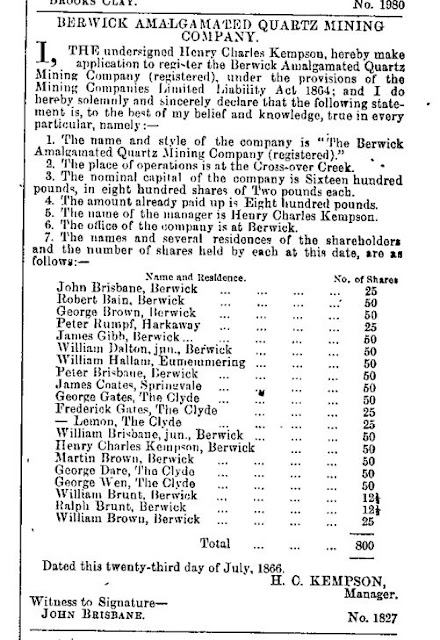This is also from The Early Days of Berwick In even earlier days it is interesting to note that that the population of Beaconsfield exceeded that of Berwick no doubt due to the gold mining activities carried out in Beaconsfield.... The gold mining was carried out in gullies named Mayfields, Walkers, Sailors and Haunted Gullies. An explanation of the latter being so named was said to be due to a miner wandering about the bush in the nude and appearing ghost like to his mates who were more or less in a similar condition of inebriation. (This is from page 115) Haunted Gully is now part of the Beaconsfield Reservoir.
This is what it says in the In the Wake of the Pack Tracks book
In 1872 H.J Valentine found gold south of Beaconsfield Upper in the Haunted Gully, now covered by Beaconsfield Reservoir. Prospecting was also carried out in Mayfield Gully to the east and Sailors and Welcome Gullies to the west. At one time over 200 miners were reported to be working in the locality. However yields were small and not payable and no mother lode located (This is from page 57)
Also from In the Wake of the Pack Tracks (page 54)
For a time gangs of Chinese diggers, many wearing pigtails arrived at the Beaconsfield Railway station by the first train on Mondays and walked in single file up the Chinaman’s track (Bowman’s track) to the Haunted Gully diggings in Upper Beaconsfield.
The Berwick Amalgamated Quartz Mining Company was registered on July 23, 1866 and as you can see from the notice in the Government Gazette, below, there were many familiar local 'names' as shareholders - John Brisbane, Robert Bain, James Gibb, William and Ralph Brunt to name a few.
Victoria Government Gazette July 27, 1866
The Happy-Go-Lucky Gold and Quartz Mining Company was registered on April 26, 1869. The General Meeting of the Company was held in January at Souter's Gippsland Hotel at Beaconsfield where William Brisbane, James Gibb, S.W Brooke, David O'Shea and Charles Souter were elected Directors. You can read an article in the Gippsland Times about this meeting here.
Victoria Government Gazette April 30, 1869
There seems to have been a few different stages of gold discovery in the area - the establishment of the Mining Companies ( Berwick Amalgamated Quartz Mining Company and Happy-Go-Lucky Gold and Quartz Mining Company) in the late 1860s, possibly as speculative ventures, then the actual discovery of gold in the region, which according to various reports on Trove was in 1873 and then there was another small gold rush in the early 1890s.
The Argus of June 16 1873 had this to say about the gold discovery in Berwick in 1873 -
The new gold field lately discovered in the ranges near Berwick about 30 miles from Melbourne, has excited some little interest, and new life has been infused by the discovery into the hitherto somewhat dull township. The scene of the operations can be reached without much difficulty. The road as far as Berwick is the main road to GippsLand, and in dry weather presents few difficulties, but in the rainy season some parts of the road are rendered almost impassable. The worst portions of the road are between Oakleigh and Mulgrave, where an attempt has been made to mend the road with clayey mud, the effect being anything but pleasant to travellers. The diggings lie about five miles north-east of the township of Berwick, amongst the spurs of the Dividing Range. The nearest way of reaching the gold-field is from the Gipps Land Hotel, near Kardinia Creek. A track leads from there to the diggings and is easily passable on horseback or on foot, but the steep ranges render the road scarcely suitable for vehicles. The mining operations are confined almost entirely to Haunted Gully and the immediately adjacent gullies. It is about two years since the prospecting for gold was commenced in that locality by some men employed by Mr. C. Wiseheart, of Melbourne, and other persons who were convinced that the country in that direction was auriferous. Some of the gullies were tested, and the result showed that the belief was not ill-founded. A shaft was sunk in Haunted Gully last year by a man named Valentine, and a quantity of washdirt was obtained averaging 6dwt per load. A prospectors' lease of 30 acres in the gully was applied for by Mr. Wiseheart and those who were acting with him, and the ground was pegged out. The news of the discovery however soon spread and in a short time the place was rushed. The ground which had been already secured by Mr Wiseheart was taken up, and in consequence of the difficulties which arose the matter was bought under the notice of the Minister of Mines. A compromise which, according to the nature of compromises, was not considered satisfactory by either side, was effected, and it was decided that Mr. Wiseheart should be allowed to choose 10 acres. He has selected 10 acres in the upper part of the gully, and the remainder of the ground which he applied for has been taken up by the other miners. The foregoing facts show the circumstances which have already transpired in connexion with this new discovery of auriferous country, but a description of the present appearance of the gold-field will doubtless prove of more general interest. You can read the rest of the article here.
There are other articles in the newspapers about the dispute between Mr Wiseheart and the other miners. I have created a list of many of the articles on Trove relating to these goldfields, you can access the list here.
There was also another minor gold discovery in the region in 1893. Clearly as Beaconsfield did not turn into another Ballarat, then the discovery must have also been economically unviable.
The Age May 7 1891





No comments:
Post a Comment